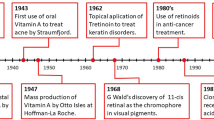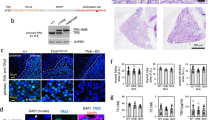Abstract
THYROID hormones and retinoic acid function through nuclear receptors that belong to the steroid/thyroid-hormone receptor superfamily (reviewed in refs 1–4). Thyroid hormone receptors (TRs) and retinoic acid receptors (RARs) require auxiliary nuclear proteins for efficient DNA binding5–10. Here we report that retinoid X receptors RXRα (ref. 11) is one of these nuclear proteins. RXRα interacts both with TRs and with RARs, forming heterodimers in solution that strongly interact with a variety of T3/retinoic acid response elements. Transfection experiments show that RXRα can greatly enhance the transcriptional activity of TR and RAR at low retinoic acid concentrations that do not significantly activate RXRα itself. Thus, RXRα enhances the transcriptional activity of other receptors and its own ligand sensitivity by heterodimer formation. Our studies reveal a new subclass of receptors and a regulatory pathway controlling nuclear receptor activities by heterodimer formation.
This is a preview of subscription content, access via your institution
Access options
Subscribe to this journal
Receive 51 print issues and online access
$199.00 per year
only $3.90 per issue
Buy this article
- Purchase on Springer Link
- Instant access to full article PDF
Prices may be subject to local taxes which are calculated during checkout
Similar content being viewed by others
References
Green, S. & Chambon, P. Trends Genet. 4, 309–314 (1988).
Evans, R. M. Science 240, 889–895 (1988).
Pfahl, M. et al. in Retinoids in Normal Development and Teratogenesis (ed. G. Morriss-Kay) 51–64 (Oxford University Press, 1992).
Glass, C. K. & Holloway, J. M. Biochim. biophys. Acta 1032, 157–176 (1990).
Zhang, X.-k., Tran, P. B-V. & Pfahl, M. Molec. Endocr. 5, 1909–1920 (1991).
Rosen, E. D., O'Donnell, A. L. & Koenig, R. J. Molec. cell. Endocr. 78, C83–C88 (1991).
Murray, M. B. & Towle, H. C. Molec. Endocr. 3, 1434–1442 (1989).
Lazar, M. A. & Berrodin, T. J. Molec. Endocr. 4, 1627–1635 (1990).
Glass, C. K., Devary, O. V. & Rosenfeld, M. G. Cell 63, 729–738 (1990).
Burnside, J., Darling, D. S. & Chin, W. W. J. biol. Chem. 265, 2500–2504 (1990).
Mangelsdorf, D. J., Ong, E. S., Dyck, J. A. & Evans, R. M. Nature 345, 224–229 (1990).
Benbrook, D. & Pfahl, M. Science 238, 788–791 (1987).
Koenig, R. J. et al. Nature 337, 659–660 (1989).
Schueler, P. A., Schwartz, H. L., Strait, K. A., Mariash, C. N. & Oppenheimer, J. H. Molec. Endocr. 4, 227–234 (1990).
Hermann, T. et al. Cell Regulation 2, 565–574 (1991).
Hoffmann, B. et al. Molec. Endocr. 4, 1727–1736 (1990).
de Thé, H., Vivanco-Ruiz, M. M., Tiollais, P., Stunnenberg, M. & Dejean, A. Nature 343, 177–180 (1990).
Klein-Hitpass, L., Schorpp, M., Wagner, U. & Ryffel, G. U. Cell 46, 1053–1061 (1986).
Forman, B. M. & Samuels, H. H. Molec. Endocr. 4, 1293–1301 (1990).
Glass, C. K., Holloway, J. M., Devary, O. V. & Rosenfeld, M. G. Cell 54, 313–323 (1988).
Graupner, G., Wills, K. N., Tzukerman, M., Zhang, X.-K. & Pfahl, M. Nature 340, 653–656 (1989).
Smith, D. B. & Johnson, K. S. Gene 67, 31–40 (1988).
Bedo, G., Santisteban, P. & Aranda, A. Nature 339, 231–233 (1989).
Hamada, K. Proc. natn. Acad. Sci. U.S.A. 86, 8289–8293 (1989).
Millán, J. L. J. biol. Chem. 261, 3112–3115 (1986).
Husmann, M. et al. Molec. cell. Biol. 11, 4097–4103 (1991).
Pfahl, M. et al. Meth. Enzym. 18, 256–270 (1990).
Lehmann, J. M., Hoffmann, B. & Pfahl, M. Nucleic Adas Res. 19, 573–578 (1991).
Zhang, X.-K. et al. New Biol. 3, 1–14 (1991).
Author information
Authors and Affiliations
Rights and permissions
About this article
Cite this article
Zhang, Xk., Hoffmann, B., Tran, PV. et al. Retinoid X receptor is an auxiliary protein for thyroid hormone and retinoic acid receptors. Nature 355, 441–446 (1992). https://doi.org/10.1038/355441a0
Received:
Accepted:
Issue Date:
DOI: https://doi.org/10.1038/355441a0
This article is cited by
-
Development of functional dendrisomes based on a single molecule of polyesterbenzylether dendrimer and their application in cancer stem cell therapy
NPG Asia Materials (2019)
-
NSC-640358 acts as RXRα ligand to promote TNFα-mediated apoptosis of cancer cell
Protein & Cell (2015)
-
Plasticity of photoreceptor-generating retinal progenitors revealed by prolonged retinoic acid exposure
BMC Developmental Biology (2011)
-
Potential of retinoic acid derivatives for the treatment of corticotroph pituitary adenomas
Reviews in Endocrine and Metabolic Disorders (2009)
-
Exposure to 9-cis retinoic acid induces penis and vas deferens development in the female rock shell, Thais clavigera
Cell Biology and Toxicology (2008)
Comments
By submitting a comment you agree to abide by our Terms and Community Guidelines. If you find something abusive or that does not comply with our terms or guidelines please flag it as inappropriate.



